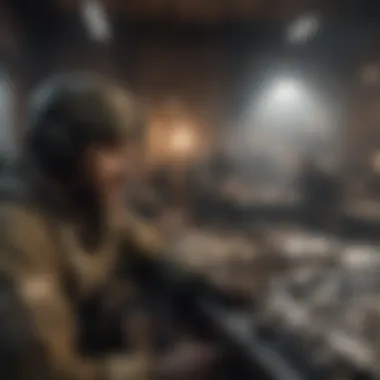Exploring Tactical Games Online: A Comprehensive Guide


Intro
In today's digital age, tactical games have surged in prominence, capturing the fascination of many players around the world. These games demand not only skill but also sharp analytical prowess and strategic maneuvering. They challenge the intellect, making each game session a cognitive exercise. This guide aims to offer insights into various aspects of tactical games, their evolution, mechanics, and online multiplayer environments, along with reflections on community interaction.
Overview of Tactical Games
Tactical games can be summarized as interactive experiences requiring players to employ strategy and critical thinking to navigate challenges. The genre includes diverse formats, from real-time strategy (RTS) to turn-based tactics. Each type offers unique gameplay dynamics. Often, players are faced with complex decisions. They must outsmart opponents and efficiently allocate resources, leading to a deeper understanding of the game's mechanics.
Evolution of Tactics in Gaming
Tactical gaming has evolved significantly, shaped by technological advancements and shifting player expectations. Early titles were often limited by hardware, but with better graphics and artificial intelligence, complex interactions have become possible. Notable milestones include the release of games like StarCraft and XCOM: Enemy Unknown. Both integrated novel tactics and strategic challenges, attracting players worldwide.
Tactical games have evolved, pushing the boundaries of strategy and player interaction.
Platforms for Tactical Gaming
Multiple platforms cater to tactical gamers, which includes consoles, PC, and even mobile devices. This diversification has made tactical gaming accessible. Popular platforms such as Steam, PlayStation, and Xbox host a wide range of tactical titles. Mobile platforms like iOS and Android have also seen an influx of apps, allowing gamers to engage in tactical play on-the-go.
Cognitive Skill Enhancement
Tactical games often require players to sharpen various cognitive skills, such as:
- Spatial awareness: Understanding maps and navigating terrain effectively.
- Problem-solving: Identifying the best course of action under pressure.
- Resource management: Allocating limited resources thoughtfully.
These skills transfer beyond gaming, benefiting players in real-life scenarios.
Community Engagement in Tactical Games
The social aspect of tactical games is important. Players often find themselves participating in forums and discussions across platforms Reddit and Facebook. Engagement enhances the experience. Collaborative play and competition in multiplayer modes build community spirit. Players frequently share strategies, updates, and personal experiences.
Regardless of experience level, tactical games invite players to immerse themselves in richly woven communities. They become part of a larger narrative focused on growth, competition, and camaraderie.
Culmination
This integrated narrative surrounding tactical games offers players a pathway into a world that tests their intellect. Understanding the evolution, community, and mechanics is critical for both enthusiasts and newcomers. In navigating these insights, players can maximize their gaming experience while enhancing their cognitive abilities.
Understanding Tactical Games
Understanding tactical games is crucial in grasping the depth and intricacies that shape this genre. Tactical games are not just about confrontation but emphasizing strategy, foresight, and decision-making processes. This section lays the foundation for comprehending how these games operate and their broader impact.
Definition of Tactical Games
Tactical games can be defined as those that prioritize strategic gameplay over reflex-based challenges. These games typically focus on individual decisions made by players, where the outcome doesn’t solely depend on luck but rather on skillful planning and execution. Often, they require players to think several steps ahead, assessing the implications of multiple actions and their potential unintended consequences. Popular examples can include both real-time strategy and turn-based titles, which distinguish themselves by their reliance on calculated choices and resource exploitation.
Key Characteristics of Tactical Games
Several key characteristics distinguish tactical games from other genres:
- Strategic Decision Making: Players are often confronted with complex scenarios requiring deep analysis and critical thinking. All decisions can lead to various potential outcomes.
- Resource Management: Many tactical games involve managing limited resources. This includes items, characters, or terrain. Effectively handling these resources can result in strategic advantages.
- Influence of Positioning: The placement of players, units, or characters on the battlefield has significant implications on overall strategy. This element makes tactical positioning a central component of gameplay.
- Variable Game Flow: Tactical games often exhibit varied pacing, relying heavily on players' choices instead of rapid action sequences, thus encouraging deliberate exploration.
Understanding these characteristics not only enriches the gaming experience but allows players to become more adept strategists in both virtual environments and real-life situations.
The true essence of tactical games is the ability to outthink opponents rather than simply outspeed them.
The Evolution of Tactical Gaming
The evolution of tactical gaming marks a significant journey of both style and substance within the broader realm of video games. Understanding this transformation is key to grasping why tactical games have carved a niche for themselves and flourished in the competitive gaming landscape. The evolution reflects not only changes in game design but also shifts in player expectations and societal dynamics that shaped the genre.
This branch of gaming began as simple, linear strategies but underwent a transformation as technology advanced, influencing graphical fidelity, gameplay mechanics, and player engagement. No longer constrained by the technical limitations of early computing, tactical games have embraced intricacies that offer players deeper challenges and engaging narratives. Moreover, analyzing the evolution helps enthusiasts appreciate current game dynamics and anticipate the genre's future trajectory.


By diving into the origins and the measured steps of tactical gaming's development through various eras, insights into both notable achievements and pioneers emerge. This foundation provides valuable perspective not just to longtime fans but also to those entering the scene for the first time. Ultimately, examining the evolution positions tactical gaming within a rich historical context, highlighting how far these experiences have come.
Origins of Tactical Games
The origin of tactical games traces back to a blend of classical strategy experiences and early digital games. During the late 1970s and early 1980s, titles like Chess on Computers began introducing strategic thought into gameplay. These early games often lacked visuals, relying primarily on text-based interactions. But even in their simplistic form, they ignited interest and captivated those focused on strategy.
As computers and technological capabilities advanced, games began to incorporate graphics and sound. The advent of personal computers brought about seminal titles like Kastle Avenger and Ultima, which blurred the lines between role-playing and tactical gameplay. The once linear confrontations evolved into multi-faceted remote skirmishes. Players had to now consider diverse ways to navigate challenges rather than relying solely on brute-force tactics.
Historically, board games also served as fertile ground for essential mechanics found in tactical games today. As war games adapted, transitioning from tabletop to screen allowed developers to amalgamate tactical thought with immersive environments. It provided unparalleled opportunities not achievable through board game mechanisms alone. These origins narrated a gradual ascent into what’s now an integral segment of online gaming.
Development Through the Years
Development through the years reflects an unmistakable progress in mechanics and immersive storytelling within tactical games. As gaming technology took impressive leaps forward, gaming studios sought to leave their mark through innovations that emphasized tactical imbrication. Titles emerged in the ’90s, like Jagged Alliance and Command and Conquer, that shifted away from simple tactical interactions to complex decision-making scenarios.
Such advancements introduced distinct mechanics like cover systems, squad formations, and resource allocation. These innovations demanded a sophisticated approach, requiring forethought and analysis. Furthermore, the move toward multiplayer modes ushered in a collaborative dimension, creating a dynamic where teamwork and communication thrived.
Years rolled on, marking the dawn of exploration within the genre. The introduction of 3D graphics and online connectivity added layers of immersion and interaction. Games like XCOM innovated with procedurally generated elements, reshaping conventional storytelling to account for unpredictable player choices.
Presently, tactical games not only engage players with exhilarating mechanics but also with artificial intelligence smarts that challenge strategies. Gamers now face enemies capable of learning, adapting, and evolving, giving depth to each encounter. With continual developments in virtual and augmented reality, the genre is poised to reach further, captivating new audiences while enriching veteran experiences. The historical growth outlines thoughtful pathways, creating a vibrant tactical gaming community across all platforms.
Platforms for Tactical Games
Understanding the platforms available for tactical games is crucial. The selection of platform significantly influences players' experiences, accessibility, visuals, and gameplay mechanics. Tactical games, often rich in strategic depth, execute differently depending on where they are played. Not only do different platforms offer unique advantages, but they also pose distinct challenges. Players need to consider their preferences and situational factors, such as portability, graphics, and social interactions.
PC Gaming
PC gaming represents one of the most robust platforms for tactical games. It provides enhanced graphical capabilities, expansive online communities, and extensive modding options. Access to powerful hardware means players can enjoy exceptional graphics and fluid gameplay. A notable advantage is the use of keyboard and mouse, allowing for precise control and quick commands in tactical scenarios.
Many tactical games thrive on the PC due to its versatility. For example, XCOM 2 showcases complex gameplay mechanics that benefit from a mouse's precision. The Steam platform consolidates many popular titles, and allows users easy access to discussions, mods, and reviews, further enhancing the gaming experience.
Considerations, however, must be made about the hardware required for optimal gameplay. While many games are tailored to a variety of specs, some of the more graphically rich titles necessitate powerful rigs. Therefore, players should look into their hardware setup before committing to certain games.
Consoles and Tactical Games
Consoles have significantly shaped the tactical gaming landscape in recent years. Devices like the PlayStation and Xbox deliver a different experience. The user interface and controller schemes can both enable and restrict gameplay nuances compared to a PC.
Some games, like Fire Emblem: Three Houses, have found dedicated audiences on consoles due to their immersive storytelling and gameplay dynamics. consoles facilitate couch co-op or split-screen play, a feature that is very appealing for a shared tactical experience. However, lack of mouse precision might reduce tactical efficiency in certain game types.
Updates and downloads are user-friendly on consoles, and exclusive titles often pull hesitant players toward these platforms. Gears Tactics, for example, successfully marries tactical gameplay with console usage. Despite certain limitations in comparison with PC, the gaming community around consoles remains strong.
Mobile Platforms for Tactical Gaming
Mobile platforms have emerged as a viable source of tactical gaming accessibility. Devices like smartphones and tablets offer flexibility over where and when gaming can happen. Emerging titles such as Wargroove have adapted well, creating a space that reaches both new and experienced players alike.
Mobile platforms typically offer touch controls, which, while convenient, may trade off depth in gameplay. Yet, many developers are innovatively addressing control schemes, making the gaming experience enjoyable. Players benefit from the convenience of immediate access wherever they may go.
However, limitations still exist. Battery life and connection issues can draw setbacks. It's crucial for mobile users to consider how session lengths fit into their routines. Yet, the rising quality of games on mobile platforms cannot be overlooked; these platforms are carving out space in the tactical gaming world.
Ultimately, selection among these platforms shapes user experience significantly. Each offers distinct advantages and experiences. Understanding these nuances guides potential players to choose the right environment where strategy and creativity can thrive.
Gameplay Mechanics in Tactical Games
The excitement and complexity of tactical games often hinge on their gameplay mechanics. These elements define how players interact with the game world and form the base for strategic decision-making. Understanding these mechanics gives gamers an edge when navigating challenging scenarios and competing against others. Important game conveyance includes understanding how action is executed, timing decisions, and managing available resources.
Turn-Based vs Real-Time Tactics
In tactical games, there are primarily two gameplay styles: turn-based and real-time tactics. Each has unique features and caters to different player preferences.
Turn-Based Tactics
Turn-based tactics provide a structured gameplay experience. Players take separate turns, making it more methodical. This setup requires careful planning for each action. Players evaluate current positions on the board or battlefield, consider potential enemy moves, and decide on a course of action. Popular games which utilize this format include XCOM and Fire Emblem. The critical aspect here is time management; since each decision shapes the upcoming moves, players must think critically to succeed.


"Turn-based games allow for in-depth reasoning while an unhurried state. Decisions weigh heavily over every turn, fostering a unique gaming experience."
Real-Time Tactics
Contrastively, real-time tactics emphasize a fast-paced environment. Players must make quick choices and adapt to unfolding situations. Tactical thinking is essential as players manage units on-the-fly—positioning, attacking, and retreating seamlessly. Games like Wargroove demonstrate this approach well through strategies that shift dynamically. Quick reflexes are imperative here. This intensified pressure can elevate thrill levels but relies heavily on skill development and familiarity with mechanics.
Resource Management and Strategy
Resource management plays a pivotal role in tactical games. It includes overseeing assets like units, money, and time. Efficient handling of these resources often determines success or failure in-game. Understandably, players must prioritize what resources to acquire and use sparingly, picking moments to invest aggressively while conserving when risk looms. This balancing act fosters critical thinking and strategic foresight.
Importance in Gameplay
Effective resource management impacts overall strategy development. Here are a few key aspects:
- Unit Allocation: Players need to decide where to place troops and when to invest in new units. Each choice affects future moves and outcomes.
- Economic Strategy: Most tactical games require planning regarding finances. Investing in what adds value—such as training new allies or enhancing gear—can make or break tactical operations.
- Time Preservation: Time, as a resource, shapes important decisions. Delaying actions can cost valuable opportunities in competitive situations.
Players who master resource management can establish lasting advantages, creating strategic diversity that can adapt as scenarios change. The principles of these mechanics, whether through timing or resource consideration, resound through the genre, creating engaging environments for players to enjoy.
Cognitive Skills and Tactical Games
Tactical games are not only a source of entertainment but also a method for enhancing cognitive skills. Engaging in these games requires players to continually adapt, think analytically, and solve problems. When played regularly, tactical games can reshape how an individual approaches challenges both in-game and in real life. Understanding the cognitive element within these games is vital for grasping their overall influence.
Problem-Solving Skills
Problem-solving is a cornerstone of tactical gaming. Each game presents a unique situation that players must assess and navigate strategically. The essence of tactical games is to question, hypothesize, and execute plans based on limited information and various uncertainties. Players choose tactics while considering the strength and weaknesses of both their unit and their opponent’s.
This requires the application of several skills:
- Analyzing Information: Players learn to digest complex scenarios quickly, emphasizing essential data.
- Formulating Strategies: Developing viable solutions often requires weighing options effectively amidst competing tactics.
- Implementing Solutions: Once a strategy is developed, executing it effectively under pressure equips players with the ability to take decisive actions.
Consequently, these skills transfer beyond gameplay, assisting individuals in everyday decision-making processes. For instance, someone accustomed to solving in-game challenges may become more proficient in resolving real-world issues in both personal and professional realms.
Critical Thinking Development
Developing critical thinking skills is another significant aspect of tactical gaming. Unlike many games that adhere to straightforward progression, tactical games often compel players to evaluate myriad factors before making choices. They must identify knowledge gaps, recognize assumptions, and assess the broader implications of their tactical choices.
This environment fosters readers' critical faculties, encouraging them to:
- Question Established Norms: Tactical challenges often necessitate altering preconceived notions in favor of more plausible options.
- Evaluate Potential Outcomes: Understanding how decisions lead to diverse consequences sharpens foresight.
- Reflect on Personal Performance: Reviewing previous mistakes or triumphs encourages iterative learning and adaptation.
As a product of these processes, an individual grows intellectually. The complex thinking induced by tactical games promotes careful consideration prior to making significant decisions, ultimately refining personal and professional judgement. The critical thinking gained from tactical gaming experiences equips individuals to confront life’s scenarios confidently.
In summary, tactical games actively engage and develop cognitive competencies that prove invaluable once the console or computer is switched off. Comprehensive understanding of their impact reveals a broader truth about gaming — it offers a platform for cognitive enrichment, steering players toward becoming more effective problem solvers and critical thinkers.
Popular Tactical Games Available Online
The realm of tactical games encompasses a variety of engaging titles that challenge players to think critically and strategically. This genre's importance is underscored by its capacity to cultivate numerous cognitive skills and foster community participation. Each game offers unique gameplay mechanics, immersive narratives, and varying levels of complexity which assist in engaging different player skill levels and preferences.
Popular tactical games serve as touchstones for what players expect in tactical gameplay. The titles captured here provide profound experiences that not only entertain but also enhance players’ decisions-making abilities. This aspect of playing offers resiliency to tactical species, enabling them to allocate resources more effectively, respond promptly to adversities, and formulate well-tested strategies. Understanding these specific elements is vital for both new and seasoned enthusiasts.
XCOM Series
The XCOM series is a hallmark of tactical gaming. Originating as a computer game in the 1990s, its revival brought tactical strategy back to the forefront. All games within this franchise highlight squad-based mechanics that allow for intensive strategy development. XCOM emphasizes covert operations, requiring players to manage resources, arrange teams, and deploy soldiers wisely against alien threats.
The graphical upgrade in newer titles, like XCOM 2, makes it refreshingly accessible while preserving hard-core tactical nuances. Aspects such as character specialization and retroactive adaptations for personal squads provide depth and endless gameplay possibilities.
Fire Emblem Franchise
The Fire Emblem series has been influential in popularizing tactical role-playing games. Traditionally known for deep narrative and character development intertwined with strategic battles, Fire Emblem presents a complex world where decisions carry weight. Players are encouraged to develop relationships between characters while maneuvering on grid-based maps.
With each title, game mechanics related to permadeath add a deeper cunning to gameplay. Losing characters means aligning more missions with emotional realignment. The latest installments have broadened its exposure in the gaming world, appealing to a diverse player base—heres a quiz for yourself, 'Who should I bring to battle?'


Wargroove
Wargroove represents a contemporary project that honors classic tactical games. This game combines charming visuals with potent gameplay that resonates with fans of the genre. Adopted mechanics like turn-based maneuvering and base-building merge strategy with creativity. Players can also design custom levels, allowing for endless community-generated content.
The simplicity of the user interface coupled with rich strategic depth makes Wargroove a valuable addition to the tactical genre. Customization enhances its longevity and associates nostalgia without losing contemporary gameplay vibes.
Impact of Online Communities
Online communities play a pivotal role in the landscape of tactical gaming. They foster connections among players, provide support, and facilitate discussions that enrich the gaming experience. Their impact is multifaceted, encompassing various aspects that enhance players' engagement and skills.
Witnessing the establishment of forums and platforms dedicated to tactical games is instrumental in developing a sense of belonging within the gaming community. These spaces host valuable discussions on strategies, game mechanics, and updates, allowing players to exchange knowledge. Players can share their experiences, seek advice, and discover advanced techniques to sharpen their gameplay. Additionally, this interaction helps demystify intricate game mechanics, promoting a deeper understanding of the styles adopted in tactical games.
Furthermore, the robust social fabric formed through these online communities can catalyze innovation in gaming. Players collaborate to develop informed strategies and even create shared resources for tactics. Friendly rivalries and cooperative missions emerge, forming a comprehensive learning atmosphere. The cumulative knowledge lends a dynamic quality to gameplay, making the narrative less solitary and more community-centric.
More than just a platform for debate, these communities catalyze participation in organized events. Players are often encouraged to join tournaments and competitive engagements, taking their skills from informal sessions to formal settings.
Community engagement not only enriches the player experience but creates a robust learning environment where ideas and strategies can intersect, elevating the overall gameplay for everyone.
Forums and Discussion Platforms
Forums like Reddit and Discord serve as hubs for tactical gamers. They enable discussions covering everything from initial strategies to advanced gameplay techniques. Different sections on platforms such as Reddit are dedicated specifically to certain games or genres. These allow players to delve into focused conversations, ask questions, and share insights.
Additionally, discussion boards frequently host threads on the latest news in tactical gaming. Players can learn about recent patches, new game releases, and community-driven initiatives that bolster competitive play. Each interaction can contribute to an atmosphere of collective learning.
For example, let’s look at the XCOM subreddit community, where players consistently post guides and videos illustrating unique approaches to the game. Not only does this benefit newcomers by enhancing knowledge, but even veteran players find inspiration in fresh strategies or game challenges that result from these discussions.
Tournaments and Competitive Play
The rise of online gaming has led to an increase in organized tournaments and formal competition. These events offer dedicated players the opportunity to showcase their skills. Typically hosted through various platforms and communities, these tournaments can range from local faceless competitions to larger internationally recognized events.
Participating in tournaments pushes players to refine their gameplay. Competition inherently encourages adaptation and improvement. Players must respond to different gaming styles and strategies, creating a fast-paced and strategic environment where quick thinking and versatility are vital. Watching competitive matches also becomes educational as players observe high-level tactics employed in real time.
Furthermore, competing can lead to unexpected rewards beyond recognition. Players forming alliances during a tournament may develop new friendships or partnerships. Such connections can persist beyond a single match.
Virtual and Augmented Reality Elements
Virtual and augmented reality are revolutionizing the gaming landscape, offering engaging alternative methods to experience tactical games. Utilizing these technologies, developers immerse players in environments where strategy takes a new forefront. Now, tactical games draw users into three-dimensional spaces where spatial reasoning and quick decision-making are essential.
Benefits of virtual and augmented reality aspects in tactical games include:
- Immersive Experience: Players become part of the action, enabling deeper strategic thinking and engagement.
- Real-Time Interaction: Seamlessly interact with environments, enhancing the characteristic of tactical maneuvering.
- Collaboration Opportunities: Players can strategize and consult with teammates more effectively within a shared virtual space.
Nevertheless, these technologies bring challenges too. Accessibility remains a concern since not all players have the necessary hardware. Additionally, the need for a developed understanding of virtual environments can pose an initial learning curve. Balancing innovation with user adaptability will be key for the future development of tactical games that harness VR and AR.
Future Trends in Tactical Gaming
The concept of tactical gaming not only reflects the strategies involved in play but also how. the genre evolves in response to changing player preferences and technological advancements. Understanding these future trends is crucial, as they shape the gaming landscape and influence how players engage with tactical games. In this section, we explore shifts that are likely to occur, the influence of esports, and what that means for gamers and developers alike.
Shifts in Player Expectations
As gaming landscapes evolve, so do player expectations. Today's gamers, having become accustomed to immersive experiences, seek more than just mechanic-rich gameplay. Today's tactical games must incorporate elements that speak to storytelling, customization, and social interaction. With so much content available, players desire a tailored experience that allows them to feel a sense of ownership and connection to the game.
For game developers, this means that simply providing a robust tactical framework is insufficient. Games must evolve not just in gameplay but in community structure. Games like XCOM and Fire Emblem show how in-depth narrative choices can influence tactical recap. This indicates a transition from conventional models to games that prioritize visual storytelling alongside strategic mechanics.
Moreover, as technology improves, so too does realism in games. Players now expect sound effects, graphics, and complicated environmental interactions that heighten immersion. Therefore, being able to adapt to these pressures is vital for attracting new players and maintaining engagement with the existing community.
The Role of Esports in Tactical Games
Tactical gaming is no longer confined to casual play but has gained robust esports traction. The relevance of this transition cannot be understated. Esports provide a structured, competitive environment that enhances engagement, thrilling players who thrive on skill-based competition.
The surge in tactical games within the esports framework incentivizes developers to refine their game mechanics. In observing League of Legends and Dota 2, one can see how precision and strategy play almost synonymous roles. As esports flourish, companies are tasked with creating environments that encourage competitive play, making aspects like teamwork, communication, and strategy pivotal.
Furthermore, these competitive events foster community. Friendships form around shared challenges and victories. Players find joy in watching professionals tackle challenges through intricate maneuvers and precise execution. Such an active spectator scene feeds back into player expectations; the regular player will aim for more skilled interactions, thus pushing developers to create content aimed at competitive balance and strategy depth.
“The evolving landscape of esports presents incredible opportunities for tactical games, bridging communities and promoting deeper engagement.”
As the tactical gaming environments continue catering to athletes and casual gamers alike, focusing on balance will be essential. In summary, understanding these future trends is not simply about anticipating what will come next; it is about realizing how this dynamic environment fuels innovations in gaming mechanics, community interactions, and consequently, the overall experience for every type of player.















